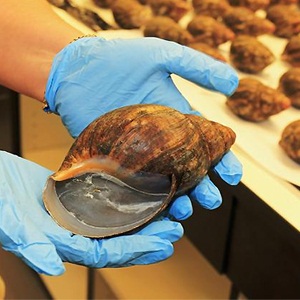
On Monday 14 July 2014 US customs inspectors at Los Angeles International Airport seized a shipment of several dozen live giant African snails.
The giant mollusks are considered a delicacy in Nigeria but they are also voracious pests that can eat paint and stucco off houses, officials said.
Weighing nearly 0.9 kg( 2 pounds) each, including their shells, and measuring about 15 cm (6 inches) in length, the 67 snails arrived from Lagos, Nigeria, in two plastic baskets with paperwork describing them as being for human consumption.
The mollusks appeared to be packaged as a personal shipment and were marked as destined for an address in San Dimas, California, about 48 km (30 miles) east of Los Angeles..
No attempt was made to conceal or smuggle the snails, the largest such shipment ever seized at LAX, but the creatures are prohibited from entry because they are deemed a highly invasive pest that pose a serious threat to U.S. agriculture, the environment and public health, the agency said.
Image: The plastic baskets that the snails were packed in. Image: US Customs and Border Control
According to the US Customs and Border Protection, the giant snails can consume more than 500 types of plants, and will even munch on the exterior of homes if fruits and vegetables are not available.
They also can carry several parasites harmful to humans, including one that can lead to meningitis, Harty said.
After they were intercepted by customs officials at the airport on July 1, specimens were sent to a local U.S. Department of Agriculture lab and then on to USDA mollusk specialists in Washington for further examination.
Experts identified the creatures as belonging to the giant African snail species, known by the scientific name Archachatina marginata. They also are commonly referred to as giant African land snails, West African snails, West African land snails or banana rasp snails.
The giant African snail in its natural habitat. Image source unknown.
Each of the mollusks, with striated brownish-orange shells, can easily fill the palm of a person's hand. They can grow up to 8 inches (20 cm) in length and may live up to 10 years in the wild, experts say.
The entire collection confiscated at the airport was eventually turned over to the USDA, which disposed of the snails through incineration, although no garlic or butter was used, Harty said.
Read more:
Snail slime - is it really a miracle beauty cure?
Snail fever declines as the climate changes
The top 10 newly discovered species of the world
10 Facts on drug mules
Image credits: U.S. Custom and Border Protection via LATimes




 Publications
Publications
 Partners
Partners










